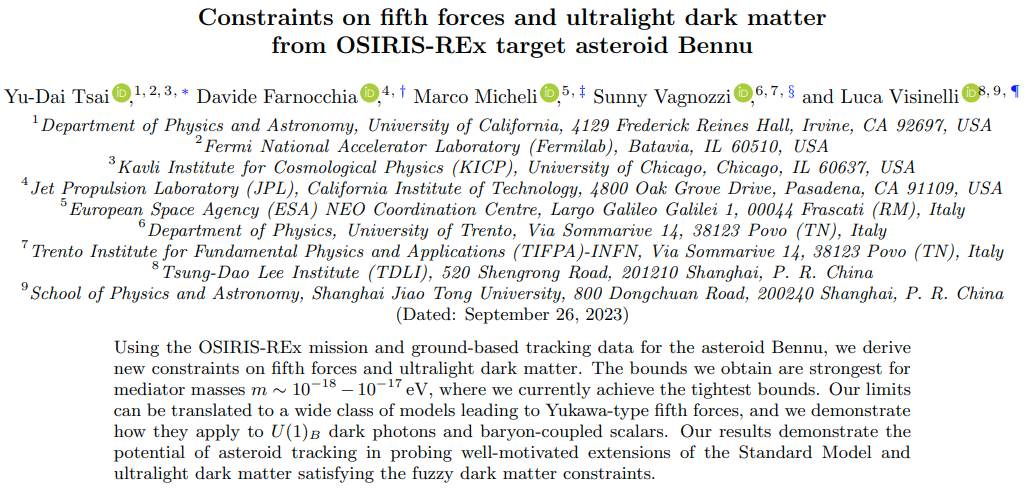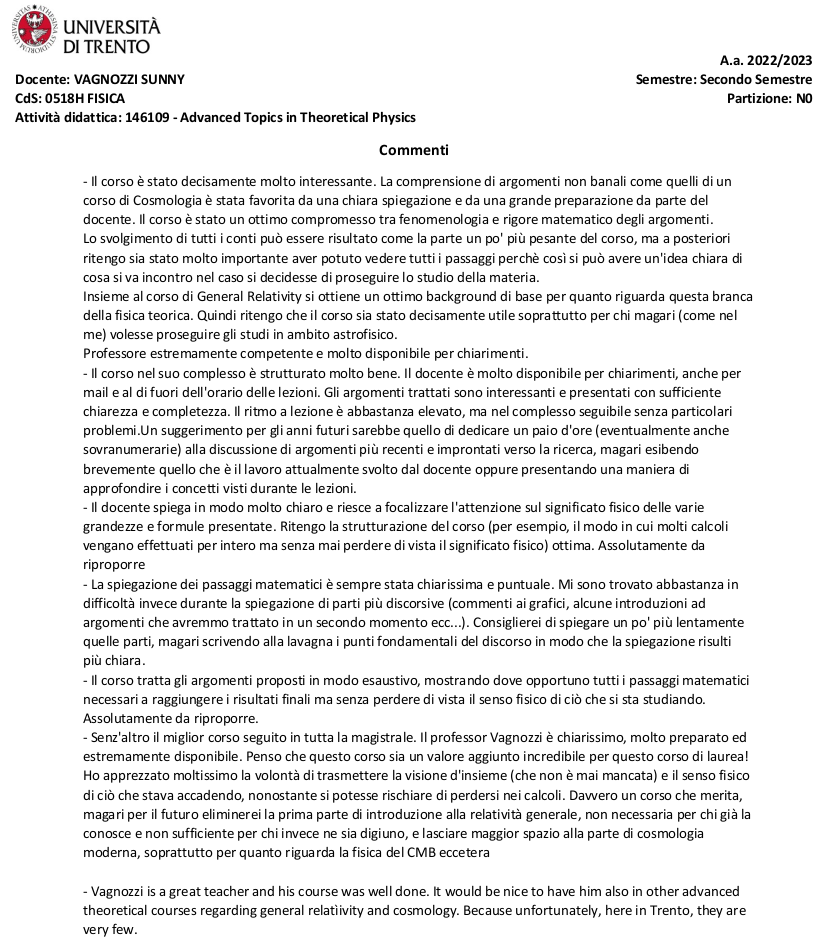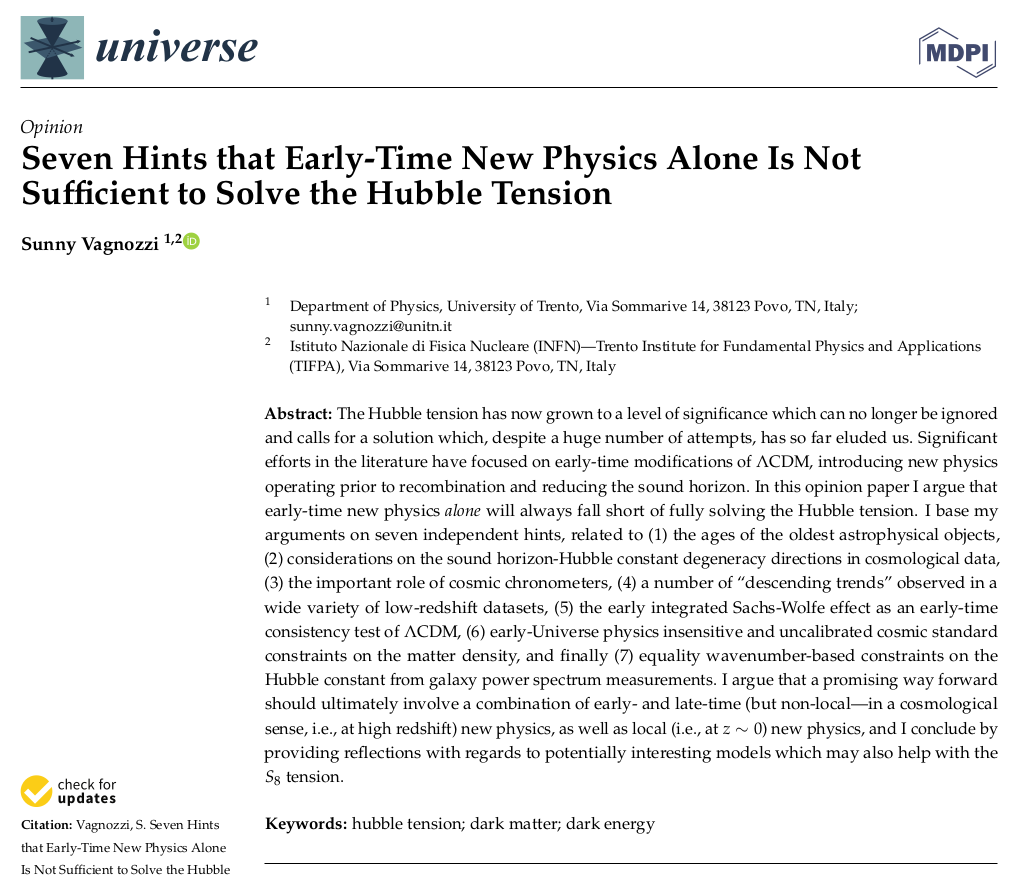I gave two talks on my works recently, a first one at RWTH Aachen (in the local cosmology plus astroparticle journal club, on my seven hints paper), and a second one at the University of Padova (on “Searching for dark energy off the beaten track”, slides here). The seminar in Padova was actually my first in-person seminar in nearly 4 years, after years of Zoom seminars. It was very nice to visit Padova after many years, and interact with what is probably one of the best (and biggest) cosmology groups in Italy. Both talks were followed by lively discussions which left lots of food for thought (and projects).
DARKTRACK project funded!
Really excited to announce that I won the Internal Call for Research 2023 grant for which I applied in August! My project “Searching for Dark Energy off the beaten track” (acronym: DARKTRACK) was one among 5 projects selected throughout the University of Trento from ~150 applications, and I have been granted in total 135.200,00€. The goal of the project will be that of developing new ways to search for (screened) dark energy, and more generally look for non-gravitational interactions of dark energy. I will use the money to hire 2 postdocs for 2 years each (ideally an astroparticle physicist and a BH theorist), so if you are interested in joining my group stay tuned for updates on the application process. The group’s future is looking extremely bright, considering that we will also have another postdoc coming with a Caritro Fellowship, and I can’t wait to start working with all these bright young minds!
Davide Pedrotti's MSc defense
Congratulations to Davide Pedrotti, who today successfully defended his MSc thesis, by the title of “Studies on Quasi-Normal Modes and Shadows of Black Holes” (with the opponent being Prof. Albino Perego)! Davide’s defense was outstanding (one of the committee members, a condensed matter physicist, said: “This is the first talk on black holes I’ve understood in years”), and in fact he received top grades and honours, i.e. 110 e Lode. In his thesis, supervised by myself and Prof. Kostas Kokkotas at the University of Tübingen, Davide studied quasi-normal modes and shadows of a number of well-motivated BH metrics beyond GR, and in particular investigated the non-trivial correspondence between the two for metrics describing rotating regular BHs: part of his thesis will be written up in a paper in the coming months, so stay tuned! During the same day, I also served as opponent for an MSc student of Prof. Bill Weber. Davide will now be enjoying a few days of deserved break before starting hiw new adventure as a PhD student in Trento in November.
Abilitazione Scientifica Nazionale as Full Professor in the 02/C1 sector (Astrophysics)
I’ve received the Abilitazione Scientifica Nazionale (National Scientific Habilitation) as Full Professor in the competition sector 02/C1 - Astronomy, Astrophysics, Earth and Planetary Physics! The Abilitazione is a requirement to be able to be considered for positions as Associate or Full Professor (depending on the level of the Abilitazione itself), and the procedure to obtain it can be quite time-consumming. The list of candidates who received the Abilitazione in the 02/C1 sector in the same round as me can be found here.
Top 2% scientists (2022 edition)
For what it’s worth, it looks like my name appeared in the list of top 2% scientists worldwide. The list was compiled by John Ioannidis at Stanford University and can be found here. It appears that for the year 2022 I’ve been ranked 6461st across all fields, and 65th in my area, whereas considering my whole career the numbers become 102993rd and 1929th respectively. Kind of cool, although these numbers really don’t mean anything (I’m one of those whose thinks the FIFA ranking doesn’t mean anything, else Belgium would have won a couple of World Cups already, so let alone ranking scientists!) and should really be taken with a lot of salt!
We got the Caritro Fellowship!
We (Max Rinaldi and I) received amazing news during the European Researchers’ Night - our application for the 2023 Caritro Postdoctoral Fellowship was successful, and our project was among the 9 selected in the whole of Trentino, across all fields! We were awarded 70.000€, and I’m super glad to announce that Simony Santos da Costa, currently a postdoc at INFN Pisa and whose application we supported as PIs, will therefore be joining our group in the coming months, for 2 years. The project we developed with Simony is entitled “Inflation and dark sector physics in light of next-generation cosmological surveys”, and consists of two parts: the scientific part is obviously targeting inflation, dark matter, and dark energy (especially in light of cosmological tensions and next-generation CMB and LSS data), whereas a second outreach part envisages a series of public lectures by Simony (who speaks Italian excellently!) at MUSE. One of the aims of the outreach part is of course to get the general public interested in science, but at the same time to raise awareness about the issue of gender (im)balance in physics, and hopefully encourage more young female students who are interested in physics to not be afraid to pursue their interests - in other words, we want Simony to be a role model for young women in physics at least in the Trentino region (let’s start small and see how things go). I’m really delighted at the prospect of having the first postdoc joining my group (though I’ll admit that, having been a postdoc myself until less than an year ago, it does feel somewhat strange), and I look forward to working with Simony, whose work I’ve been following for some time now!
Notte della Ricerca 2023
I had great fun taking part in the Notte della Ricerca (European Researchers’ Night - an Europe-wide public outreach event, meant to explain science and its impact to the public in fun and inspiring ways) at MUSE, the Science Museum of Trento. Together with Max Rinaldi and Chiara Cecchini (Max’s PhD student) we prepared four very simple posters, each related to one of our research themes: Dark Matter, Dark Energy, Black Holes, and the CMB. No words, just pictures, the idea being that of getting people curious and encouraging them to come and talk to us about our work. It definitely worked, and we got tons of people of all ages and backgrounds asking us all sorts of questions, many of which related to white holes (somewhat unsurprisingly I would say). Despite my throat being very sore from all the talking, it was a truly fun night, and I hope we inspired some of the younger minds to come and study physics!
Negative cosmological constant and JWST paper accepted in JCAP!
My paper with Shahnawaz Adil, Upala Mukhopadhyay, and Anjan Sen, where we show how a dark energy model featuring a negative cosmological constant with an evolving component on top can potentially explain the puzzling JWST observations (see this earlier news item), has been accepted for publication in JCAP! The revision requested was pretty minor, but a notable (and in my opinion rather important) addition is the new Fig. 1 I produced, where we show the effective equation of state of this dark energy model. In some cases it goes through a singularity, which indicates the point where the total energy density of the dark energy switches sign. The singularity is nothing to worry about, as we argued. You can read the preprint version of the paper on arXiv: 2307.12763.
Constraints on fifth forces from OSIRIS-REx tracking data for Bennu
Really excited about the new preprint we just posted with Yu-Dai Tsai, Davide Farnocchia, Marco Micheli, and Luca Visinelli, where we use OSIRIS-REx tracking data for the asteroid Bennu to set new constraints on fifth forces and ultralight dark matter - in certain ranges of mediator mass these are among the tightest constraints ever obtained! This is a follow-up to our earlier paper in JCAP where we only considered the effect of such particles on the asteroid orbital precession. In our new preprint we are instead using real tracking data from the OSIRIS-REx mission and ground-based optical and radar telescopes, gathering as much information as possible on Bennu’s full trajectory. The timing is, to say the least, perfect, as in the past days OSIRIS-REx has been making headlines, being on its way back to Earth with a sample of Bennu. You can read our results in the preprint we just posted on arXiv: 2309.13106.
Seven hints paper makes cover page of September issue!
My seven hints paper - Universe 9 (2023) 393 - has been selected as cover story for the September 2023 issue (Volume 9, Issue 9) of Universe! The production team did a very nice job in designing the cover story image, which you can find here. My paper was also selected as a Feature Paper and an Editor’s Choice. I also recommend to take a look at the Special Issue where my paper was published, which features a bunch of other really interesting papers!
Teaching feedback
I just received the feedback from students of the courses I delivered last semester (General Physics I part 2 and Advanced Topics in Theoretical Physics). The feedback was excellent, with a satisfaction index of 100%! Given the amount of work I put into preparing the courses, and the enthuasism I tried to instill, I was really happy to read the students’ comments, especially for the Advanced Topics in Theoretical Physics aka Cosmology course (see below) - the students really appeared to appreciate my efforts to always help them not lose sight of the big picture, even when the latter risked being obscured by the complexity of the calculations (especially when it came to deriving the Boltzmann equations). I do indeed find it important (not only in my work but also in my research) to, so to say, “not lose sight of the forest for the trees”. I found the feedback really rewarding, and the comments will motivate me to do even better in the coming semesters!
Teaching restarts today
Today my teaching duties restart again. Fortunately this semester I’ll have a much lighter load, both because I’ll only be teaching one course (again Advanced Topics in Theoretical Physics, following the same program as last semester), and obviously because I already delivered the same course previously. Last semester’s course was a great success and was truly satisfying, with a number of excellent students attending (many of which will end up doing their MSc theses with me), so I hope this semester will be as successful. And there will definitely be much more time for research this time! Once more, all my teaching material will be made publicly available, while being regularly updated, on the English and Italian versions of my teaching page.
PhD defense of Tiziano Schiavone
Today I had the pleasure of serving as external committee member for the PhD thesis discussion of Tiziano Schiavone, a PhD student at the University of Pisa supervised by Giovanni Marozzi, Giovanni Montani, and Giuseppe Fanizza. Tiziano wrote an excellent thesis by the title of “Large-scale structure of the Universe in General Relativity and beyond”, which on the one hand studied the impact of local inhomogeneities on cosmological observables, and on the other hand examined ways to distinguish between ΛCDM and competing cosmological models, particularly those based on modifications to gravity, especially in light of cosmological tensions. The other two committee members were my collaborator Eleonora Di Valentino and Scilla Degl’Innocenti. Unfortunately I could not be present in person for the first ever PhD defense of which I am committe member (I would have loved to visit the beautiful city of Pisa after many years). Tiziano’s defense was excellent (the final mark we gave was “ottimo”, which roughly translates to something between “very good” and “excellent”), and he will now be moving to the University of Lisbon as a Della Riccia fellow for his first postdoc - congratulations Tiziano!
Corfu2023 Workshop on Tensions in Cosmology
Straight after the XXV SIGRAV conference, I am travelling to Corfu, Greece, to attend the Corfu2023 Workshop on Tensions in Cosmology. The workshop, as the name suggests, is focused on cosmological tensions, with special attention to the Hubble tension. I have been particularly looking forward to this workshop, firstly because it will be an occasion to catch up with some friends colleagues I haven’t seen in a long time (e.g. Vivian Poulin), and finally meet several people I’ve written many papers with (e.g. Eleonora Di Valentino) or frequently interacted with online (Leandros Perivolaropoulos, Jackson Levi Said, and Özgür Akarsu, to name but a few), but never actually met in person, but also because I’ve never been to Greece before. I will also be delivering a plenary talk on “Seven hints that early-time new physics alone is not sufficient to solve the Hubble tension” (whose slides you can find here), obviously focused on my “seven hints” paper. I look forward to lots of fruitful discussions, and interesting workshop, and a series of exciting social events (including a boat trip and a traditional Greek dinner)!
Receiving the SIGRAV Prize
The official award ceremony for the 2023 SIGRAV Prize (see this earlier news item), during which I received the medal from SIGRAV President Professor Stefano Liberati, was held today during the XXV SIGRAV conference. It is really a great honor to receive this Prize, given the extremely prestigious list of earlier winners. Beyond a symbol of academic recognition, it is of course a symbol of responsibility to continue carrying out quality research and mentoring the younger generations, and I will strive to continue doing so. Upon receiving the Prize I have also officially become a lifetime member of SIGRAV.
XXV SIGRAV conference
I’m really excited to be attending the XXV SIGRAV conference of the Italian Society for General Relativity and Gravitation in the beautiful city of Trieste! I will be picking up the 2023 SIGRAV Prize (see this earlier news item) and on the occasion I will also be delivering a plenary talk on “Searching for dark energy off the beaten track” (whose slides you can find here), presenting some of the ideas I’ve been developing over the past years. This is my second in-person conference after the pandemic, but the first which actually required travelling (the previous one took place in Trento). There are lots of people attending whose work I’ve been following for years, or whom I’m working together with or even wrote papers with, but never had the chance to meet in person (just to mention a few, Vitor Cardoso, Che-Yu Chen, Gaetano Lambiase, Gabriele Gionti, and Joe Silk), so I look forward to many interesting discussions!
Media coverage for seven hints paper
My seven hints paper has been picked up by Universe Today, who write a nice piece which you can find here:
www.universetoday.com/163026/its-going-to-take-more-than-early-dark-energy-to-resolve-the-hubble-tension/
The same piece was later picked up by Phys.org. Enjoy the read! 😃
Seven hints that early-time new physics alone is not sufficient to solve the Hubble tension
I’m very excited to share that my latest single-author paper (on which I already gave three talks) has now been published in Universe (in a Special Issue guest edited by Eleonora Di Valentino, Leandros Perivolaropoulos, and Jackson Levi Said)! This is an opinion paper where I argue that the Hubble tension is even nastier than it looks and that, if we insist on it requiring new physics, it will not be enough to add early-time (i.e. pre-recombination) new physics - instead, I present seven reasons in favor of my argument that one should combine early- and late-time new physics, and potentially local new physics as well. The choice of number seven is motivated by Miller’s law, which states that the number of objects the average person can hold in working memory is 7±2. The full bibliographic coordinates for the paper are Universe 9 (2023) 393, and you can also find it in preprint form on arXiv: 2308.16628. Here is the link to the paper (which is published Open Access).
Internal Call for Research 2023 grant application
I just submitted an application for an UniTrento Internal Call for Research 2023 grant, funded by the Autonomous Province of Trento (PAT). I based my scientific case largely on the ERC StG application I submitted last year, obviously after taking into account reviewer feedback. I should hear back in October and, if successful, this would allow me to hire a couple of postdocs - I’m keeping my fingers crossed!
The state of the dark energy equation of state
The dark energy equation of state w is one of the cosmological parameters a number of next-generation surveys aim to measure particularly well, and it is therefore quite surprising that there wasn’t a single paper after the 2003 Melchiorri-Mersini-Ödman-Trodden paper (“The state of the dark energy equation of state”) comprehensively discussing state-of-the-art constraints on w from a number of probes (rather, various papers usually focus on one probe at a time), especially in light of the possible impact of w on cosmological tensions. In today’s new preprint with Luis Escamilla, William Giarè (yes, this was one of the main things William and I worked on during his visit to Trento), Eleonora Di Valentino, and Rafael Nunes, we therefore found it very timely to provide a snapshot of the state of the dark energy equation of state, circa 2023 of course. What we found confirmed a suspicion I have had for a long time, i.e. that current constraints on w (when including data from the CMB) cluster around w~-1.03, and in any case just into the phantom regime. Why is this? We haven’t been able to provide a clear answer, but hopefully you will find some interesting discussions on this and other points in the preprint we just posted on arXiv: 2307.14802.

















